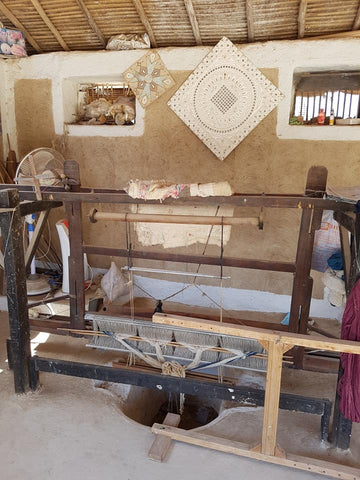Last week, we posted the first of a two part series about Master Weaver Shamji Vishram. Part I: Master Weaver Shamji Vishram and the Weavers of Bhujodi can be found here.
Cont'd...
That March in 2018, we made our way down the bumpy road to Bhujodi, passing by a lengthy wall covered in sign boards, and then the houses and shops lining the street, past the temple, children playing cricket and people on motorcycles going about their daily activities. We were dropped off in front of a beautiful wooden gate in the middle of a long white stone wall extending on either side. Walking inside, we entered a courtyard with a few buildings and covered areas, a charpoi – a wooden day bed where the seat is crafted with bands of woven rope, and a white cow pleasantly chewing on grass.

One of the cows that live in the courtyard of Shamji Bhai's home. Photo: Arindam Bhattacharjee, June 2023

A Charpoi (Day Bed). Photo: Arindam Bhattacharjee, June 2023
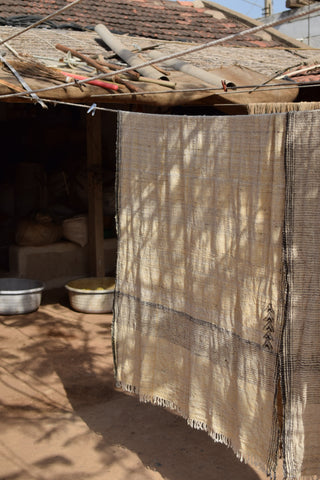
Handwoven Bhujodi textiles, fresh off the loom, drying in the sun. Photo: Arindam Bhattacharjee, June 2023
Looking more closely, eyes adjusting from the glare of the sun against the white buildings, you begin to see evidence of the weaving that happens here – a pit loom, with various bundles of local indigenous handspun wool and indigo dyed cotton, baskets filled with spindles wound with different coloured threads, and an open door that leads into the main showroom where hundreds of shawls in a multitude of colours, fibres and weights are piled and hung, waving in the breeze from the fans that keep the room ventilated in the heat.

Akshayan and Pery in the Courtyard outside the showroom piled high with shawls and blankets of wool, cotton and silk. Photo: Sarah Dunn, March 2018.
A pit loom inside the Courtyard. Photo: Arindam Bhattacharjee, June 2023

Tools of the trade: a selection of yarn and bobbins. Photo: Sarah Dunn, March 2018.
In the past, Kachchhi weaves were constrained by limited designs and materials, reflecting specific cultural identities within traditional communities. As local residents began opting for more affordable power loom products while maintaining traditional designs, weavers sought new markets beyond their communities. This shift resulted in commercialization, with standardized designs tailored for mass production. To meet demands for cost-effective products, many weavers transitioned to using acrylic yarns under market pressures for cheaper alternatives.
‘Our weaving was linked to local communities for centuries. In 1950s, our weaving was on verge of extinction due to advent of power loom & mill made fabrics. My father did not lose hope and steered our craft to outside markets, training us too.’
Vankar Shamji Vishram
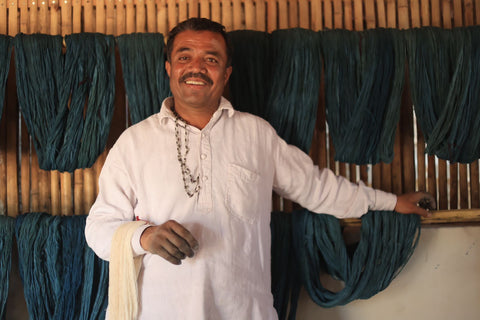
Vankar Shamji Bhai Vishram, inside his Indigo dye house.
Shamji sets himself apart by crafting unique pieces and small scale production, incorporating new weave designs using natural dyes such as acacia, lac, and indigo on various wool, cotton, and silk varieties. He has revolutionized materials, methods, designs, techniques, and products through extensive innovation, creating a distinctive product line featuring limited edition designs characterized by diverse colors, patterns, and fibers. His innovations extend to a traditional border technique and a weft-faced weaving approach, where the warp remains concealed in the design. Tassels grace the entirety of some shawls instead of being confined to borders.
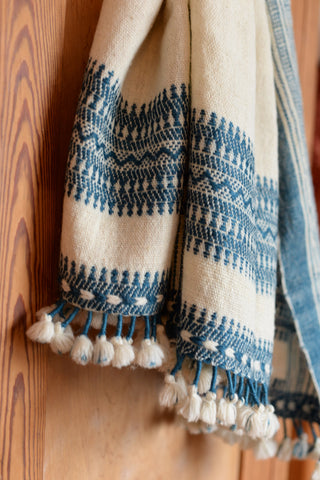
One of Shamji Bhai's shawls from our collection at BOTHO in Tübingen made using indigenous wool (Desi Oon), with traditional braided border, hand tied tassles and extra weft motifs. Photo: Sarah Dunn, March 2024
'With my father’s anchoring and our efforts, we were able to slowly establish a business around our traditional craft. While he and my elder brother continued to make products for commercial markets to support our family, I decided to start innovating and would show my creations to buyers and started getting an encouraging response. I would interact with visitors from outside coming to our village and accompanied my elder brother to exhibitions and fairs. There also I got opportunity to meet new customers and buyers, see new trends.'
Vankar Shamji Vishram

Forefront: Pure white indigenous wool, and behind, the gleaming gold of tussar silk combined with merino wool with a traditional border motif. Photo: Sarah Dunn, March 2024
'With the advantage of my education I soon realized that we would have to change to survive with our craft. The shawls made by our community were being copied on power loom and we found that the demand was decreasing. I came in contact with designers in India and Overseas, who were working with traditional crafts. From them I realized that one could play with colours and designs and create new products. I started experimenting with new yarns, colours, designs and created products for contemporary markets.'
Vankar Shamji Vishram

Naturally dyed yarn displayed at Shamji Bhai's home. Photo: Arindam Bhattacharjee, June 2023
Shamji's commitment to sustainability is evident, not only in his use of indigenous varieties of wool and cotton, but also in his revival of the traditional craft ecosystem, involving local Rabari women in spinning yarns, natural dyeing, and weaving. Additionally, women play crucial roles in finishing techniques like tasseling, embroidery, and mirror work.
Furthermore, Shamji has initiated educational activities, introducing weaving to young children in his community, fostering an early interest in the craft. Many young weavers undergo apprenticeship in the workshop, earning a steady income through weaving.
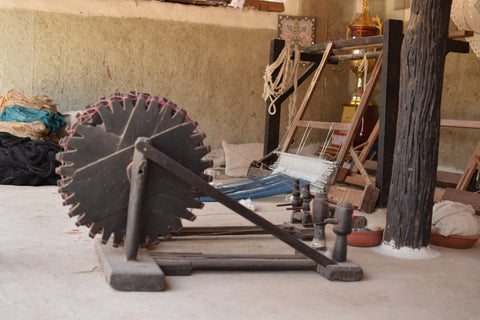
A traditional charkha (spinning wheel) at Shamji Bhai's home in Bhujodi. Photo: Arindam Bhattacharjee, June 2023
Arindam returned to Bhujodi in June 2023, to source a set of shawls. He was able to visit the weaving workshop and the indigo dye studio, where Shamji demonstrated the process of dyeing a hank of locally grown indigenous kala cotton. Through a series of whatsapp video calls, photos and voice messages between Bhujodi and Germany that day, we were able to choose a set of unique handwoven shawls for the shop we were preparing to open in the Fall of 2023.
Those shawls, a variety of styles from rustic indigenous wool blankets to fine merino shawls with mirror work, simple cotton striped with indigo and undyed golden tussar silk with glorious tassles, were instantly popular.
We are incredibly delighted to share that Shamji Bhai will be joining us here in Germany at the end of this month for a series of workshops, lecture demonstrations and a trunk show. For information and sign up, click the following link:
INFO & SIGN UP
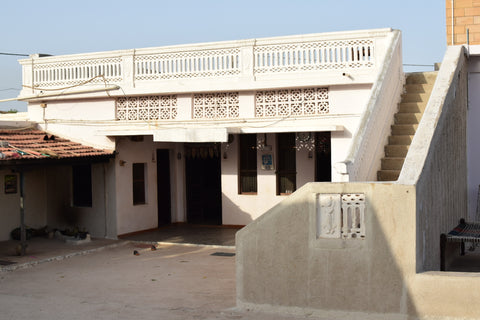
Home. Bhujodi Village, Kachchh, Gujarat. Photo: Arindam Bhattacharjee, June 2023

Indigo dyed yarns in the dye house, a gradient displayed from hanks that have been dyed from 0 - 14 dips in the indigo vats. Photo: Arindam Bhattacharjee, June 2023
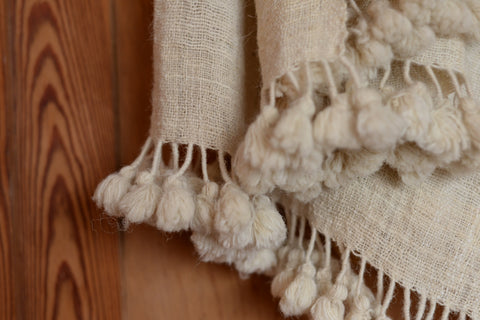
Pure handwoven indigenous wool (Desi Oon), a simple design with hand tied pom poms. Photo: Sarah Dunn, March 2024

